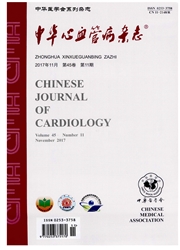

 中文摘要:
中文摘要:
目的 利用心脏磁共振获得健康成年人左心室整体及局部功能参数.方法 利用快速平衡稳态采集快速成像对20名健康成年人行心脏磁共振检查,分别测量左心室整体功能参数,左心室基底部、中间部、心尖部3层以及左心16个节段的局部功能参数,并比较左心室不同层面之间、同一层面不同节段之间的局部功能参数.结果 (1)左心室整体功能参数:舒张末期容积为(109.17±19.52)ml;收缩末期容积为(37.76 ± 14.16)ml;左心室射血分数为(65.93±7.79)%;室壁增厚率为(83.24 ±40.82)%;纵向缩短率为(15.51±3.78)%;轴向缩短率为(31.78±9.55)%;舒张末期质量为(95.20±19.95)g. (2)左心室局部功能参数:左心室收缩末期室壁厚度在3个层面之间差异无统计学意义(P>0.05).舒张末期室壁厚度、室壁增厚率在中间部与心尖部之间差异无统计学意义(P>0.05),而中间部、心尖部与基底部之间差异均有统计学意义(P均< 0.05).轴向缩短率基底部与中间部之间差异无统计学意义(P>0.05),而基底部、中间部与心尖部之间差异均有统计学意义(P均< 0.05).同层面不同心肌节段之间的收缩末期室壁厚度差异无统计学意义(P>0.05).基底部和中间部的前间隔段和下间隔段之间各局部功能参数差异均无统计学意义(P均> 0.05).3个层面的间隔段舒张末期室壁厚度均为最大,室壁增厚率均为最小,且与其他各段之间差异均有统计学意义(P均<0.05).结论 轴向缩短率和纵向缩短率是心脏磁共振左心室整体功能评估的新指标;正常成年人的左心室局部功能明显不一致,在各层面中心尖部收缩功能最强,同层面中间隔段收缩功能最弱.
 英文摘要:
英文摘要:
Objective To establish cardiac magnetic resonance imaging (MRI) derived left ventricular (LV) global and region function parameters in normal adults. Methods Twenty normal adults were examined with fast imaging employing steady-state (Fiesta)acquisition sequence of cardiac MRI, LV global function and LV region function were measured at basal, middle, apical level and at 16 LV segments. The regional function parameters among different levels and different segments of the same level were analyzed. Results ( 1 ) LV global function : end-diastolic volume ( 109. 17 -+ 19. 52 ) ml ; end-systolic volmne ( 37.76 _+ 14. 16 ) ml ; ejection fraction ( 65.93 _+ 7.79 ) % ; wall thickening ( 83.24 _+ 40. 82 ) % ; longitudinal shortening ( 15.51 _+ 3.78 )% ; fractional shortening ( 31.78 _+ 9.55 )% ; end-diastolic mass ( 95.20 _ 19. 95 )g. (2)LV regional function: In each LV level, there was no significant difference in end-systolic wall thickness ( P 〉 0. 05 ). End-diastolic wall thickness and wall thickening were similar between the middle and apical levels, but there were significant differences between middle and apical levels with the basal level ( both P 〈 0. 05 ). End-systolic wall thickness of the middle and the apical level was similar, but there were significant differences between middle and apical levels with the basal level ( both P 〈 0. 05 ) . At the segments of the same level, end-diastolic wall thickness and the relevant regional function parameters between the segments of anteroseptal and inferoseptal at base and middle level were similar ( P 〉 0. 05 ) ; the end-diastolic wall thickness was the largest and the WT was the minimal at the septal segments of three levels, and the difference were significant between the septal and other segments in the same level (P 〈 O. 05). Conclusions Fractional shortening and longitudinal shortening provide new indicators for assessing LV global function by cardiac MRI. There is obvious
 同期刊论文项目
同期刊论文项目
 同项目期刊论文
同项目期刊论文
 期刊信息
期刊信息
